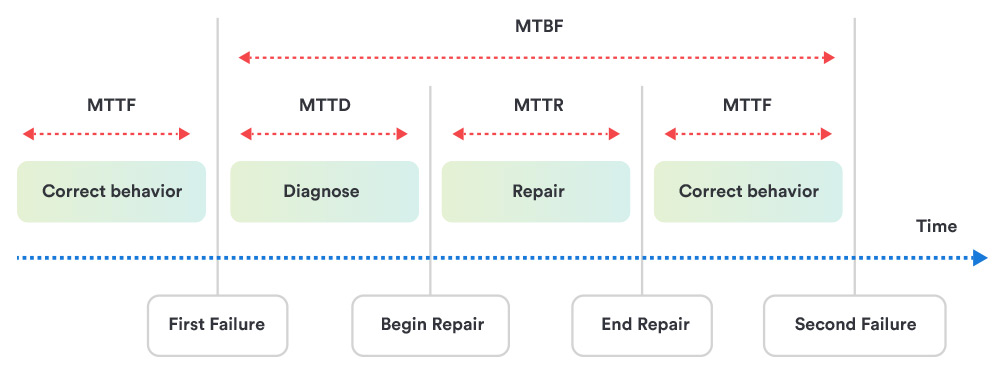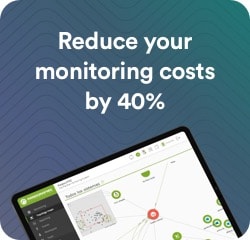Introduction to MTTR
Mean Time to Repair (MTTR) is an essential metric for evaluating the efficiency with which a system or equipment becomes operational again after a failure. The MTTR measures the total time from when a fault is detected until full functionality is restored. This metric is key because it provides insight into the availability and reliability of a system, assessing both the severity of failures and the effectiveness of repair efforts.
MTTR Calculation
To calculate the MTTR, a simple formula is used:

For example, if a production line experiences two failures in one month, and four hours are spent on total repairs, the MTTR is 2 hours. This calculation identifies how long, on average, a system is down after a failure, thus providing a basis for improving processes and reducing downtime.

MTTR in the context of other metrics
MTTR is not only relevant on its own, but is also used alongside other key metrics to provide a full view of system performance. Among these metrics is the Mean Time Between Failures (MTBF), which measures the average time between repairable failures and is an indicator of system reliability:


While MTBF focuses on the time between failures, MTTR assesses the effectiveness of repairs. Together, these indicators make it possible to plan predictive maintenance and prevent future problems.
Another relevant metric is the Mean Time to Acknowledge (MTTA), which measures the time it takes for a team to respond to a failure after being notified:


A low MTTA can significantly improve MTTR, as a quick response allows the repair process to be started earlier, thus reducing total downtime. Mean Time to Failure (MTTF) is used for non-repairable systems, providing an estimate of the average time until a definitive failure takes place:

Together with MTTR, these metrics help identify critical areas that require attention to improve system availability and reliability.
Bridge the gap between IT data and business value with Pandora FMS
The total monitoring solution for full observability
Root Cause Analysis (RCA) and its relationship with MTTR
A technique that complements the use of MTTR is Root Cause Analysis (RCA), which focuses on identifying and eliminating the underlying causes of problems rather than treating symptoms alone. By performing an effective RCA, organizations can improve MTTR by addressing issues at their source, reducing the recurrence of incidents and, consequently, the time to repair.
The Root Cause Analysis is intimately related to the concept of service and the calculation of the availability of said service (measured by the SLA).
A monitoring tool that aims to provide solutions to improve the quality of service and shorten MTTRs, must be able to see the organization with a holistic RCA approach, adding all the pieces of the puzzle so that the RCA is real, since not all the parts that make up the solution of a problem can be from the domain that affects the problem.
Benefits of MTTR Monitoring
MTTR tracking and optimization offers multiple benefits. First, it minimizes downtime, ensuring systems are available more quickly after a failure. This not only improves service continuity, but also reduces productivity losses. In addition, an optimized MTTR helps improve system reliability by identifying and addressing problematic components or processes. This, in turn, can lead to a reduction in repair costs, as it decreases the need for emergency interventions, which are often more costly and disruptive.
A lower MTTR also has a positive impact on customer satisfaction, as reduced downtime improves user experience. In a competitive environment, offering a reliable service can be a significant advantage, increasing customer loyalty and strengthening the company’s reputation. In addition, using MTTR data for decision making provides organizations with a solid foundation to prioritize technology investments and optimize their maintenance processes.
MTTR calculation is complex and there is no “box” tool that solves this problem. It should be understood that if you consider the previous definition, MTTR is “the total time from when a fault is detected until the full feature is restored”, but what does full feature include?, usually several elements.
A real example
If we talk about repairing the information screen of a fast food restaurant, the fault may be in the screen, in the cable, in the equipment to which it is connected, in the application, in the application database, on the disk, in the operating system or in the internet service provider. Complex, right? That’s why very related to MTTR is the concept of SLA (Service Level Agreement) which is broader, since it recognizes the word Service, something that better encompasses that “simple screen” in something more complex such as “Display service of informative screens in store”. An SLA is measured by the percentage of time it is operational. For example, 98.5% of the time in a week would be to support a 2hr 31 min time stop (calculated using Pandora SLA calculator).
If we know that the weekly service drop limit is 2.5 hours, your MTTR must always be lower than that value, measuring the MTTR is related to measuring the recovery time of each individual element.
If before the screen failure, you have to go one by one looking at all the elements that make up the “service”, it is very possible that before reaching that two and a half hours of margin you do not even know what went wrong. You should individually monitor all the parts that make up that service, but… How to do it if some parts are hardware, other software and some are not even yours?, easy, with a flexible tool that can obtain metrics from different sources, such as Pandora FMS.
The same tool should not only measure each individual item, but give you the SLA values in real time, to know how you are delivering the service.
At Pandora FMS we offer you constant IT evolution to keep you ahead of the monitoring curve
We ensure uninterrupted operations, unwavering security
Common challenges when calculating MTTR
Calculating MTTR presents significant challenges. One of them is the clear definition of what constitutes a “repair”, since different organizations may have varying interpretations. It is critical to establish clear, standardized criteria for when a repair begins and ends to ensure the accuracy of the metric. There may also be limitations to data availability, especially in systems that experience infrequent failures. Implementing data management systems that record detailed information about each incident is crucial to overcoming this challenge. The key point here is to get back to the concept of service. It may affect the MTTR, but if the service is not operational again, it is useless, unless you are measuring elements separately and you are interested at the macro level.
Another challenge is variability in repair times, which may vary significantly based on the complexity of the problem. Carrying out detailed analyses of repairs helps to identify patterns and factors that influence variability, allowing strategies to be implemented to optimize repair processes. Additionally, unscheduled downtimes may complicate the collection of accurate data on repair time, but the use of real-time monitoring systems may mitigate this issue.
Think that many times the elements involved in an incident do not depend on you, so you need not only to monitor, but to inventory all the elements belonging to a service. It is another of the necessary tasks in a monitoring tool, to have a detailed inventory.
MTTR under monitoring
In the context of monitoring, MTTR is a vital metric for evaluating the effectiveness with which to manage and solve incidents. Monitoring systems such as Pandora FMS collect data in real time to detect failures as they take place, enabling a faster response. This not only helps reduce MTTR, but also improves operational efficiency by identifying issues before they become critical incidents. To solve a problem, you first need to know WHAT happened, WHEN it happened and especially WHERE it happened. The important thing is not only to fix the mess, but not to repeat it in the future.
Predictive analytics is another powerful tool in monitoring, using history data to predict potential future failures and enable proactive interventions. By anticipating potential issues, organizations may reduce downtime and MTTR by addressing issues before they impact operations. Alert system integration ensures that responsible teams are notified immediately, reducing response time and improving MTTR.
The importance of MTTR in ITIL and ITSM
In incident management (ITSM), MTTR is a key indicator to evaluate the effectiveness of the support team in solving issues. An effective incident management process involves systematically detecting, classifying, diagnosing and solving problems. Automation of repetitive tasks and continuous training of technical staff are strategies that may significantly reduce MTTR, allowing teams to focus on more complex problems and improve the quality of customer service.
Improving MTTR in incident management not only ensures that organizations comply with Service Level Agreements (SLAs), but also improves customer experience by reducing the negative impact of incidents. For example, in critical sectors such as health or information technology, a low MTTR is critical to ensuring the availability of essential services and equipment.
An advanced ITSM tool should be able to quantify metrics related to an incident, such as MTTR, and incident resolution time. In addition, you must be able to identify these metrics by each element of your CMDB and by the teams that manage them, that way you may identify which elements are more prone to failure or which teams respond best to problems.
You cannot improve what you cannot measure.
Find out which is the best option for your monitoring needs
Interesting stories told by our clients and partners.
Conclusion
In conclusion, MTTR tracking and optimization are essential to improve operational efficiency and customer satisfaction. Tools such as Pandora ITSM and Pandora FMS provide advanced capabilities to manage these metrics, enabling organizations to deliver a more reliable and efficient service. By integrating MTTR with other key metrics and approaches based on service-level tracking (with SLAs), companies can achieve a significant improvement in the perception of the service they offer to their customers.
Get your trial version of Pandora FMS, a complete solution!
Get to know in detail all Pandora FMS capabilities
Any doubts? We answer the most frequently asked questions about Pandora FMS
Transparent pricing, investment with powerful results









